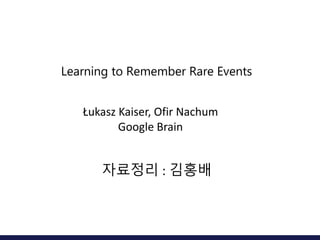
Learning to remember rare events
- 1. Learning to Remember Rare Events Łukasz Kaiser, Ofir Nachum Google Brain 자료정리 : 김홍배
- 2. 논문을 한마디로 정리하면 제목만 보면 도대체 뭔 소리인지 ? 주 내용은 Matching Networks for One Shot Learning에 메모리 기능을 추가
- 3. 일반적인 이미지 분류작업 Feature Extractor Fully Connected Layers Classifier 일반적인 이미지 분류작업의 경우, 다음과 같이 NN을 구성하여 훈련을 통하여 parameter를 tuning한다.
- 4. 여기서는 기존에 아주 잘 훈련된 Feature Extractor와 FCL를 활용 FCL의 마지막 Layer로부터 이미지에 대한 Feature Vector를 얻는다 Feature Vector 또는 query, q를 메모리 겸 분류기에 입력 Feature Extractor Fully Connected Layers Memory & Classifier Feature Vector, q
- 5. 메모리의 구조 K[1] V[1] A[1] K[2] V[2] A[2] . . . . . . K[i] V[i] A[i] . . . . . . K[n] V[n] A[n] M[1] M[2] . . M[i] . . M[n] = i번째 메모리 M[i]는 다음과 같이 3개의 요소로 구성 K[i] : i번째 memory feature(key) vector, normalized one ІІ K[i] ІІ=1, ϵ R1xkey size V[i] : i번째 memory class indicator, integer A[i] : i번째 memory cell age, integer
- 6. 메모리 작동원리 q∙K[1] V[1] A[1] q∙K[2] V[2] A[2] . . . . . . q∙K[i] V[i] A[i] . . . . . . q∙K[n] V[n] A[n] • 주어진 이미지에 대한 Feature vector를 FCL로부터 받아 이를 Query, q(normalized one, ІІqІІ=1, , ϵ R1xkey size )로 메모리에 전달하면 • 메모리 셀에 있는 Key vector, K[i]와 유사도(Cosine Similarity)를 계산한다. q와 K[i]가 유사하면 ~1 이고, 관계없으면 ~0 • 만약 q∙K[i]가 가장 큰 값이면, 주어진 이미지의 class는 V[i]
- 7. 작동 예 • 만약 0 ~ 9까지의 10 digits을 분류하는 작업을 예로 들면 • “5”를 입력할 경우, class “5”에 해당하는 Key vector, K[6]와 query의 유사도가 가장 큰 값을 나타낼 것이며 ㅂ K[1] “0” A[1] K[2] “1” A[2] K[3] “2” A[3] K[4] “3” A[4] K[5] “4” A[5] K[6] “5” A[6] K[7] “6” A[7] K[8] “7” A[8] K[9] “8” A[9] K[10] “9” A[10] 5 q
- 8. 작동 예 • 만약 0 ~ 9까지의 10 digits을 분류하는 작업을 예로 들면 • “7”를 입력할 경우, class “7”에 해당하는 Key vector, K[8]와 query의 유사도가 가장 큰 값을 나타낼 것 K[1] “0” A[1] K[2] “1” A[2] K[3] “2” A[3] K[4] “3” A[4] K[5] “4” A[5] K[6] “5” A[6] K[7] “6” A[7] K[8] “7” A[8] K[9] “8” A[9] K[10] “9” A[10] 7 q
- 9. 메모리 Tuning • 앞과 같이 작동되기 위해서는 메모리가 Tuning이 잘 된 경우 • 메모리 Tuning은 어찌해야 하나 ? • 우선 주어진 이미지에 따라 계산된 query, q와의 유사도에 따라 다음과 같이 메모리의 key vector간 k개의 Nearest Neighbors를 계산한다. (n1, n2, ….., nk)= NNk(q,M) n1> n2> …..> nk
- 10. 메모리 Tuning 즉 주어진 이미지가 class V[n1]에 해당하는 경우이다. • query, q가 주어질 경우, 다음과 같은 2경우가 존재한다. Case 1) 메모리 내에 q와 유사한 key vector가 존재하는 경우 이 경우, n1에 해당하는 메모리의 key vector만 update한다. 두 벡터의 normalized 평균값으로 대체 또한 갱신되었으므로 age를 reset시켜준다.
- 11. 메모리 Tuning • query, q가 주어질 경우, 다음과 같은 2경우가 존재한다. Case 2) 메모리 내에 q와 유사한 key vector가 존재하는지 않는 경우 이 경우, 메모리에 새로운 key vector와 class 를 저장하여야 함. 어디에 저장하여야 하나 ? 가장 오래된(즉 사용빈도가 가장 낮은) 메모리에 저장 * 메모리 갱신이 끝나면 모든 메모리의 age를 +1시켜준다.
- 12. 메모리 Loss의 정의 • 여기서 Loss는 단지 Performance Indicator 역할 • 메모리의 성능은 분류대상 이미지가 메모리에 저장된 class에 되도록 많이 포함될 수록 좋게 나타나도록 즉 분류대상에 대한 정보를 많이 가질 수록 성능이 좋다 ! V[np] : 기존의 class에 포함된 경우, positive neighbor V[nb] : 기존의 class에 포함되지않은 경우, negative neighbor Query와 negative neighbor사이의 유사도 되도록 작게 Query와 positive neighbor사이의 유사도 되도록 크게
- 13. 실험결과 : Omniglot dataset • 기존의 메모리를 사용한 onse-shot learning 에 비하여 우수한 성능을 나타냄.